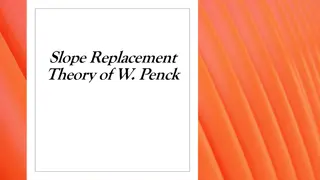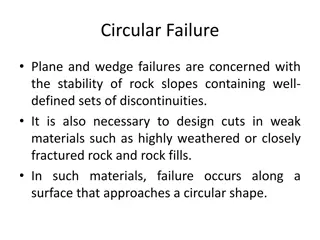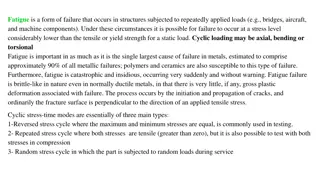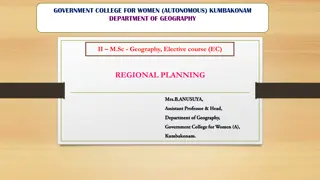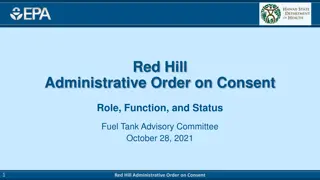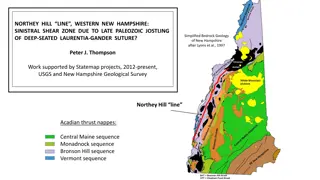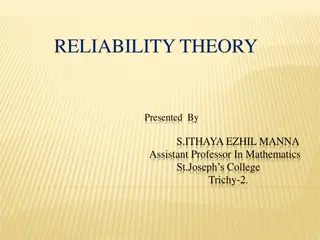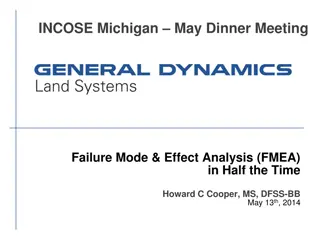Macromechanical Analysis of Lamina and Tsai-Hill Failure Theory Overview
The Tsai-Hill failure theory is based on the strengths of a unidirectional lamina, incorporating longitudinal and transverse tensile and compressive strengths, as well as in-plane shear strength. This theory, derived from the distortion energy theory, provides criteria for determining lamina failure based on specific interactions and strength parameters. The equations derived from the theory offer insights into predicting lamina failure under various loading conditions.
- Lamina analysis
- Tsai-Hill failure theory
- Unidirectional lamina
- Strength parameters
- Distortion energy theory
Download Presentation

Please find below an Image/Link to download the presentation.
The content on the website is provided AS IS for your information and personal use only. It may not be sold, licensed, or shared on other websites without obtaining consent from the author. Download presentation by click this link. If you encounter any issues during the download, it is possible that the publisher has removed the file from their server.
E N D
Presentation Transcript
Chapter 2 MacromechanicalAnalysis of a Lamina Tsai-Hill Failure Theory Dr. Autar Kaw Department of Mechanical Engineering University of South Florida, Tampa, FL 33620 Courtesy of the Textbook Mechanics of Composite Materials by Kaw
The failure theories are generally based on the normal and shear strengths of a unidirectional lamina. In the case of a unidirectional lamina, the five strength parameters are: ( )ult 1 T Longitudinal tensile strength ( )ult 1 C Longitudinal compressive strength ( )ult 2 T Transverse tensile strength ( )ult 2 C Transverse compressive strength ( )ult In-plane shear strength 12
Based on the distortion energy theory, Tsai and Hill proposed that a lamina has failed if: ( ) ( 2 ) ( ) 2 1 2 2 G 2 3 2 2 + + + + + G G G G G G G G 2 3 1 3 + 1 + 2 3 1 2 2 1 3 2 23 2 13 2 12 2 2 2 1 + < G G G 1 2 3 4 5 6 This theory is based on the interaction failure theory. The components G1thru G6of the strength criteria depend on the strengths of a unidirectional lamina.
( ) ( 2 ) ( ) 2 1 2 2 G 2 3 2 2 + + + + + G G G G G G G G 2 3 1 3 + 1 + 2 3 1 2 2 1 3 2 23 2 13 2 12 2 2 2 1 + < G G G 1 2 3 4 5 6 ( ) , 1 T = Apply to a unidirectional lamina, then the lamina will fail. Hence, Equation reduces to: ( 1 3 2 = ult G + G 1 ult )( ) 2 T 1
( ) ( 2 ) ( ) 2 1 2 2 G 2 3 2 2 + + + + + G G G G G G G G 2 3 1 3 + 1 + 2 3 1 2 2 1 3 2 23 2 13 2 12 2 2 2 1 + < G G G 1 2 3 4 5 6 ( ) , = 2 T Apply to a unidirectional lamina, then the lamina will fail. Hence, Equation reduces to: ( 2 3 1 = ult G + G 2 ult )( ) 2 T 1
( ) ( 2 ) ( ) 2 1 2 2 G 2 3 2 2 + + + + + G G G G G G G G 2 3 1 3 + 1 + 2 3 1 2 2 1 3 2 23 2 13 2 12 2 2 2 1 + < G G G 1 2 3 4 5 6 ( ) , = 2 T Apply to a unidirectional lamina, and assuming that the normal tensile failure strength is the same in direction (2) and (3), then the lamina will fail. Hence, Equation reduces to: ( 2 2 1 G + G 3 ult )( ) 2 ult = T 1
( ) ( 2 ) ( ) 2 1 2 2 G 2 3 2 2 + + + + + G G G G G G G G 2 3 1 3 + 1 + 2 3 1 2 2 1 3 2 23 2 13 2 12 2 2 2 1 + < G G G 1 2 3 4 5 6 ( )ult = 12 Apply to a unidirectional lamina, then the lamina will fail. Hence, Equation reduces to ( ) 2 12 6 G 12 2 ult 1 =
1 2 1 = G ( ( 1 2 2 2 T T ) ) 2 1 ult ult )( ) )( ) )( ) ( ) 12 ( ( ( 2 ult = T 1 + G G 2 3 1 1 1 = G 2 2 2 2 ult T 1 ( ) = T 1 + G G ult 1 3 2 1 1 2 ult = T 1 + = G G G 1 2 2 3 2 2 T 1 ( ) ult 2 ult 2 1 = G 6 1 1 = G 6 2 2 ( ) 12 ult
Because the unidirectional lamina is assumed to be under plane stress - that is, , = = = 0 23 31 3 ( ) ( 2 ) ( ) 2 1 2 2 G 2 3 2 2 + + + + + G G G G G G G G 2 3 1 3 + 1 + 2 3 1 2 2 1 3 2 23 2 13 2 12 2 2 2 1 + < G G G 1 2 3 4 5 6 2 2 2 1 1 T 2 2 12 1 + + 2 ult T T ( ) ( ) ( ) ( ) 1 2 12 ult ult ult 1
Unlike the Maximum Strain and Maximum Stress Failure Theories, the Tsai-Hill failure theory considers the interaction among the three unidirectional lamina strength parameter. The Tsai-Hill Failure Theory does not distinguish between the compressive and tensile strengths in its equation. This can result in underestimation of the maximum loads that can be applied when compared to other failure theories. Tsai-Hill Failure Theory underestimates the failure stress because the transverse strength of a unidirectional lamina is generally much less than its transverse compressive strength.
= = = 2 , 3 , and 4 S S S Find the maximum value of S>0 if a stress of is applied to a 60o lamina of Graphite/Epoxy. Use Tsai-Hill Failure Theory. Use properties of a unidirectional Graphite/Epoxy lamina given in Table 2.1 of the textbook Mechanics of Composite Materials by Autar Kaw. x y xy FIGURE 2.33 Off-axis loading in the x-direction
The stresses in the local axes are: 0 2500 0 7500 0 8660 2 . . . S 1 0 7500 0 2500 0 8660 3 = . . - . - S 2 0 4330 0 4330 0 5000 4 - . . - . S 12 1 . 1714 0 10 1 0 2714 = - . S. 10 1 0 4165 - . 10
2 2 2 1 1 T 2 2 12 1 + + 2 ult T T ( ) ( ) ( ) ( ) 1 2 12 ult ult ult 1
2 2 2 + + ) ) 1 1 2 2 12 S 1 Y X X X 1 2 2 ( ( ( ( ( ( = T , 0 X if 1 1 1 ult = C , 0 if 1 1 ult ) ) = T , 0 X if 2 1 2 ult = C , 0 if 1 2 ult ) ) = T , 0 Y if 2 2 ult = C , 0 if 2 2 ult ( )ult = S 12







